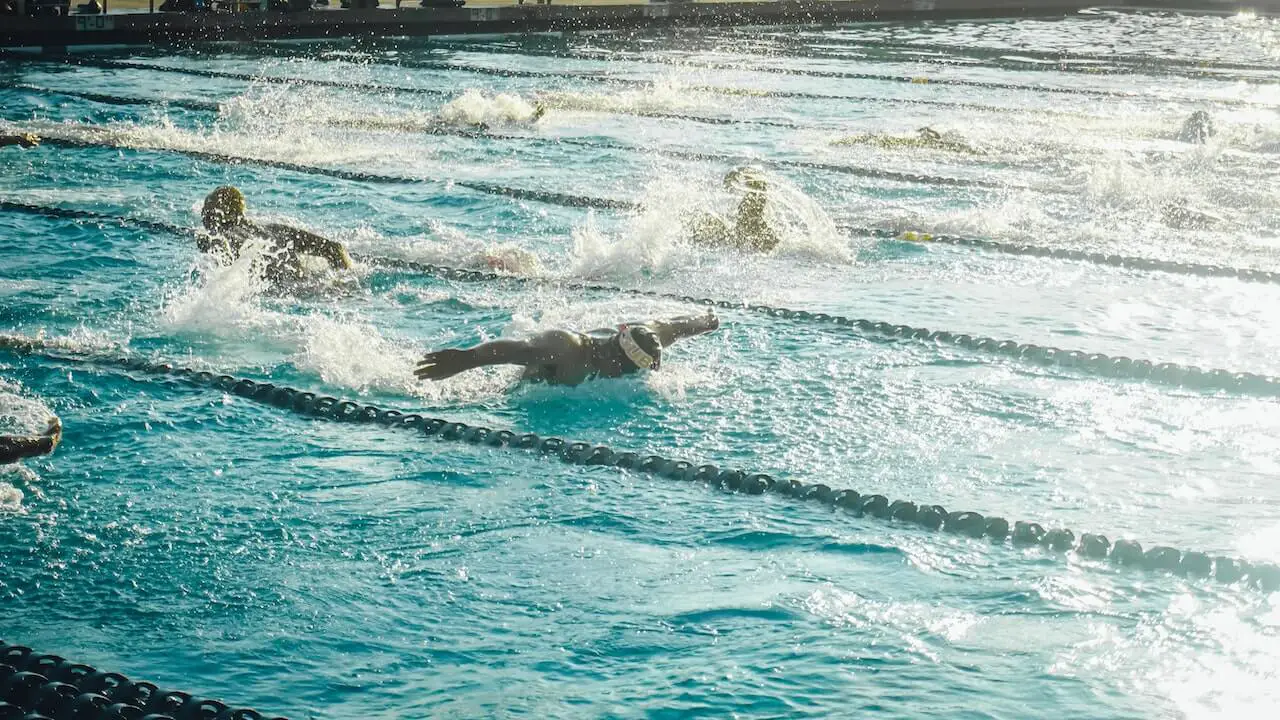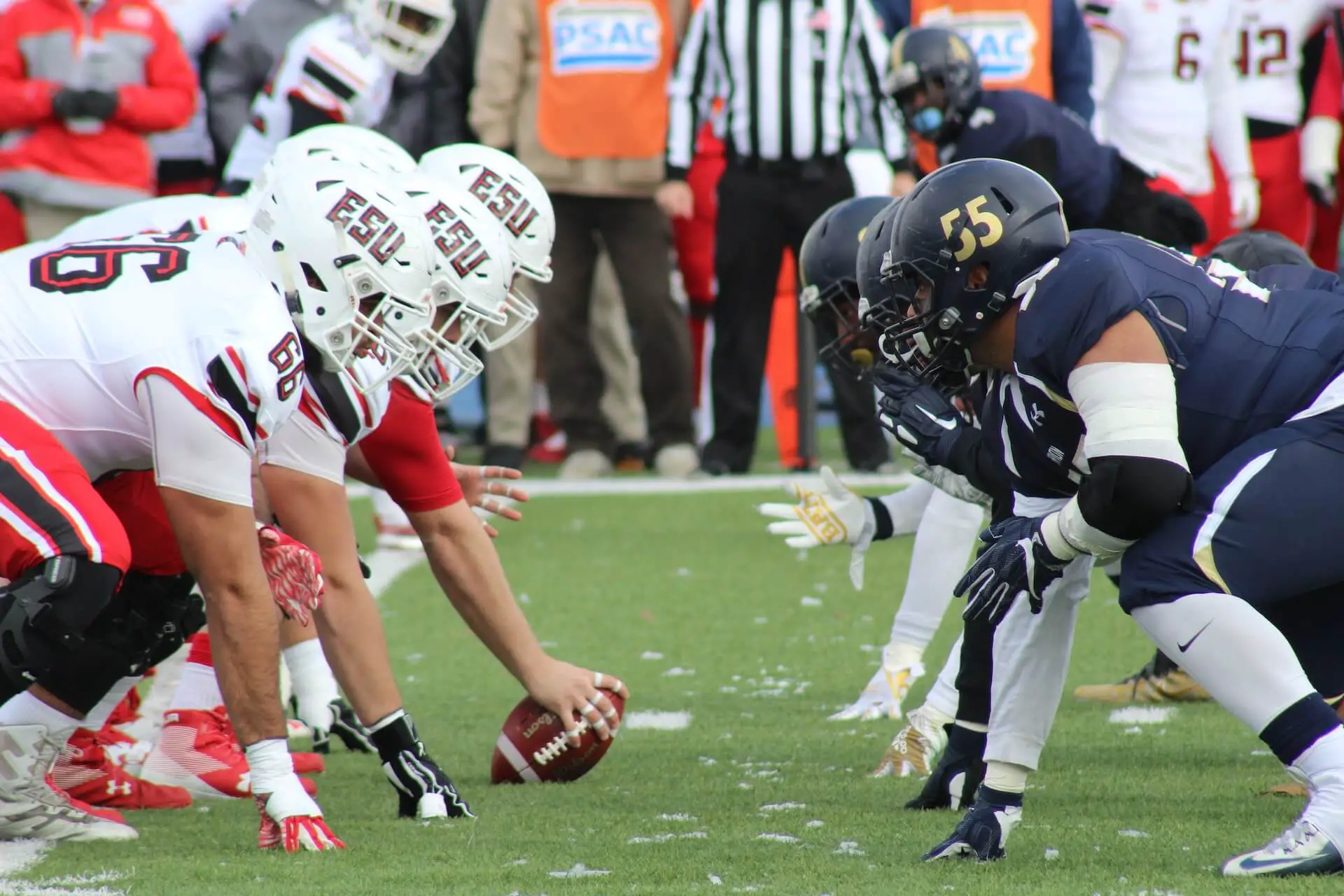When it comes to sports, many people wonder which one is more challenging: swimming or football? Well, the answer might not be as clear-cut as one might think, since this is not exactly an apples to apples comparison.

Whether you’re comparing swimming to soccer or American football, all three sports require incredible endurance, rigorous training, strong mental fortitude, tireless training, and grueling physical demands. Out of the three sports, swimming arguably has the least risk of serious injury, and it is also less of a team sport, so arguably it is easier than football.
In this article, we’ll discuss various factors that can help you determine whether swimming is indeed harder than football, or vice versa.
Is Swimming Harder Than Football (Soccer)?

Endurance
Swimming requires a high level of endurance, as you need to maintain a steady pace throughout the race or practice session. You constantly engage your muscles and cardiovascular system to power through the water and maintain your technique.
On the other hand, football also tests your endurance as you are on the move for 90 minutes, and increasing your stamina is crucial for competing at a higher level.
Both sports have moments where bursts of speed is needed, and other times maintaining a steady and controlled pace is preferable. Since swimming takes place in the water, which is 800 times denser than air, it would appear as if swimming is harder.
However, if you are measuring difficulty in terms of calories burned, then running burns more calories than swimming when performed at a similar intensity for the same amount of time compared to running, with running burning significantly more calories at the highest levels of performance.
Training
Swimming training can be intensive, usually consisting of multiple sessions per week, focusing on various aspects such as technique, speed, and endurance.
Football training also requires dedication and hard work, with sessions that cover agility, ball handling, and coordination.
While both sports demand commitment to training, the type and intensity of the training sessions may vary, and personal preference may be a factor in determining which is harder.
Risk of Injury
In swimming, the risk of injury is generally lower due to its low-impact nature. However, repetitive movements can lead to overuse injuries.
Football presents a higher risk of injury because of its physical nature, with players more likely to sustain sprains, bruises, and fractures from contact with other players or overextension of muscles.
Therefore, football has a much higher risk of injury than swimming.
Physical Demands
Swimming requires endurance, stamina, strength, and lung capacity. Although it requires upper body strength and agility, it doesn’t require the same amount of muscle power as soccer does.
The buoyancy of water minimizes the impact on joints and muscles, allowing for a smoother range of motion. With that said, the physical demands of swimming can be intense, especially during competitive races.
For soccer, in any given competitive match, a random combination of explosive and powerful activities, together with technical and tactical gestures, is performed in an intermittent manner over a 90-minute game.
Those who study the physical demands of soccer generally agree that the average running distance in adult male professional soccer is between 6 and 8.5 miles (9.7 to 13.7 km).
In comparison, the longest swimming event in the Olympic games is 1,500 m (0.93 miles), and even in an Iron Man triathlon, the swimming portion is 3.9 km (2.42 miles).
Technique
Both swimming and football have intricate techniques that need mastering. Swimming technique is vital to achieving speed and efficiency in the water. Different strokes require fine-tuning of body position, breathing patterns, and timing.
In football, mastering the various techniques for dribbling, passing, and shooting takes a lot of practice and precision. Good technique can be the deciding factor between success and failure in both sports.
Is Swimming Harder Than American Football?

Endurance
Swimming requires a high level of endurance since you’re constantly moving and using different muscle groups in your body.
Unlike in football, where players may have breaks between plays, you must keep swimming to stay afloat and move efficiently in the water. This continuous exertion demands tremendous stamina. Especially in long-distance events, maintaining proper technique and efficient breathing throughout the race can be very challenging.
Training
Both swimming and football require rigorous training regimens to excel. However, the water environment adds an extra dimension to swimming training, where you must learn to be comfortable and efficient. Swimming training often incorporates dryland exercises, cardiovascular workouts, technique drills, and strength-building sessions.
Risk of Injury
Football has a higher risk of injury due to its contact nature, but that doesn’t mean swimming is injury-free. Swimmers can still suffer from overuse injuries, especially in their shoulders and knees. However, swimming is generally considered a low-impact sport and often recommended for rehabilitation purposes.
Meanwhile, football is well-known for causing long-term injuries, which shed a light on concussions and the risk of brain injury when suffering too many blows to the head, which boxers also frequently suffer from.
Physical Demands
Both sports demand immense physical strength and agility. Football players need to sprint, tackle, and use their body weight to their advantage.
Swimming, on the other hand, requires a mix of power and finesse to maneuver through the water. Muscular imbalances can be common in swimmers due to the repetitive nature of their strokes, and both sports require a focus on body conditioning and strengthening to perform at their best.
Technique
Swimming and football both demand precise techniques honed over time. In swimming, each stroke has a specific set of movements, and mastering these techniques can be the difference between winning a race or struggling to finish.
Football players must refine their skills on the field, such as passing, catching, and tackling, which require both precision and power. In both sports, proper technique can minimize the risk of injury and maximize performance.
While difficulty may differ depending on your personal preference and strengths, swimming and football both have their unique challenges in terms of endurance, training, risk of injury, physical demands, mental toughness, and technique. However, I have to give the edge to football – its physical demands and risks of injury make it a much more grueling sport to be an athlete for.
Frequently Asked Questions
Is swimming more physically demanding than football?
While both swimming and football require intense physical exertion, football is more physically demanding than swimming. For soccer, the sheer amount of running done in a single game far surpasses anything swimming has to offer. In American football, the amount of power athletes need to generate often surpasses what swimmers need to exert even in swim sprints. However, swimming is physically demanding in its own way.
How do the athletic demands of football and swimming compare?
In football, you need to sprint, shift directions, jump, and tackle, which builds explosive power and agility. Swimming, on the other hand, develops your cardiovascular endurance, muscular strength, and flexibility. While both sports involve different types of physical demands, they are both challenging in their ways.
In terms of difficulty, how do swimming and football rank among other sports?
According to sports medicine experts, swimming is among the hardest summer Olympic sports, along with water polo and gymnastics. Football is also considered challenging due to its combination of speed, strength, and strategy. However, it’s hard to rank one above the other as the definition of “difficult” can vary depending on an individual’s abilities and preferences.
Which sport requires more strength and endurance: swimming or football?
Swimming typically requires more endurance, as it involves continuous movement and the ability to maintain a steady pace for extended periods. Football, however, demands short bursts of energy along with the strength required for tackling and holding off defenders. Both sports require strength and endurance in different ways.
What makes swimming and football different in terms of training intensity?
Swimming exercises the entire body, with a focus on building cardiovascular stamina and muscular strength, while also developing proper breathing techniques and pacing. Football training, in contrast, emphasizes explosive movements, agility, and anaerobic fitness, with an added focus on strategy and teamwork.
How do the skills needed for swimming and football differ?
Swimming skills involve mastering various strokes, improving breathing techniques, and refining pacing and body position in the water. Football skills, on the other hand, can range from ball handling and footwork to tackling, blocking, and executing set plays. While both sports require a high degree of physical prowess, the specific skills needed are quite different.
Additional Sources:
- https://journals.lww.com/nsca-scj/Abstract/2020/06000/Physical_and_Energetic_Demand_of_Soccer__A_Brief.7.aspx
- https://us.humankinetics.com/blogs/excerpt/physical-demands-on-the-soccer-player
- https://www.topendsports.com/world/lists/fittest-sport/espn.htm
- https://www.insider.com/the-3-hardest-olympic-sports-according-to-experts-2021-7

